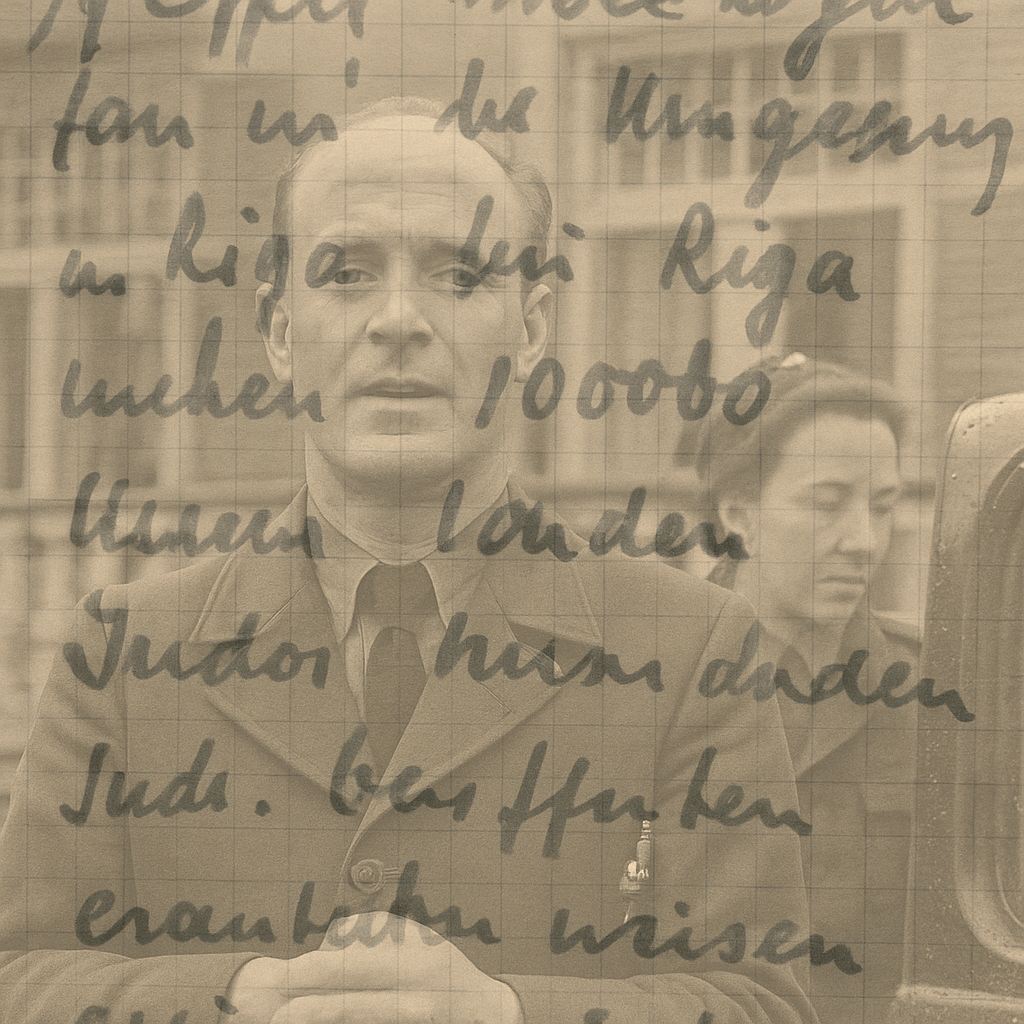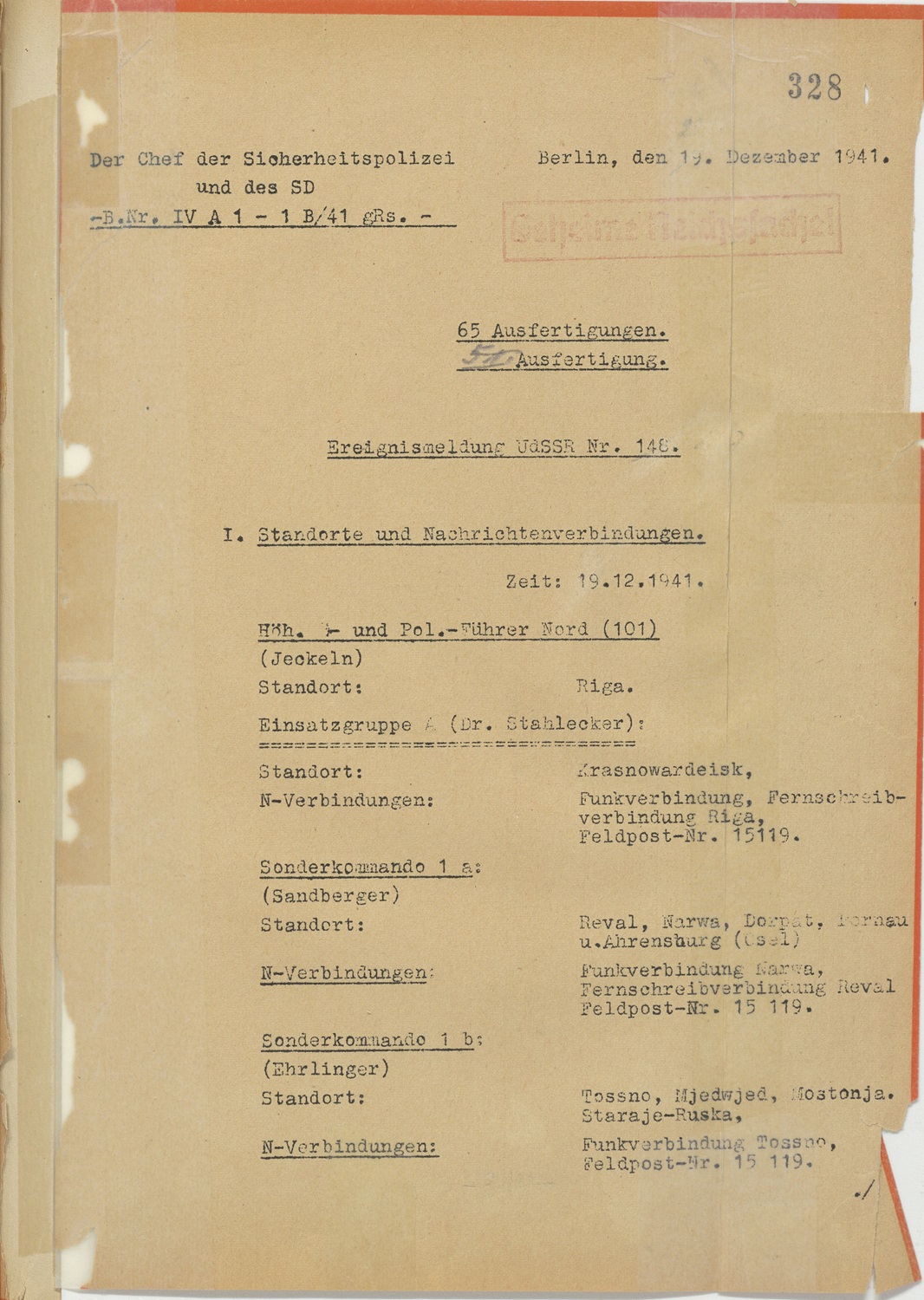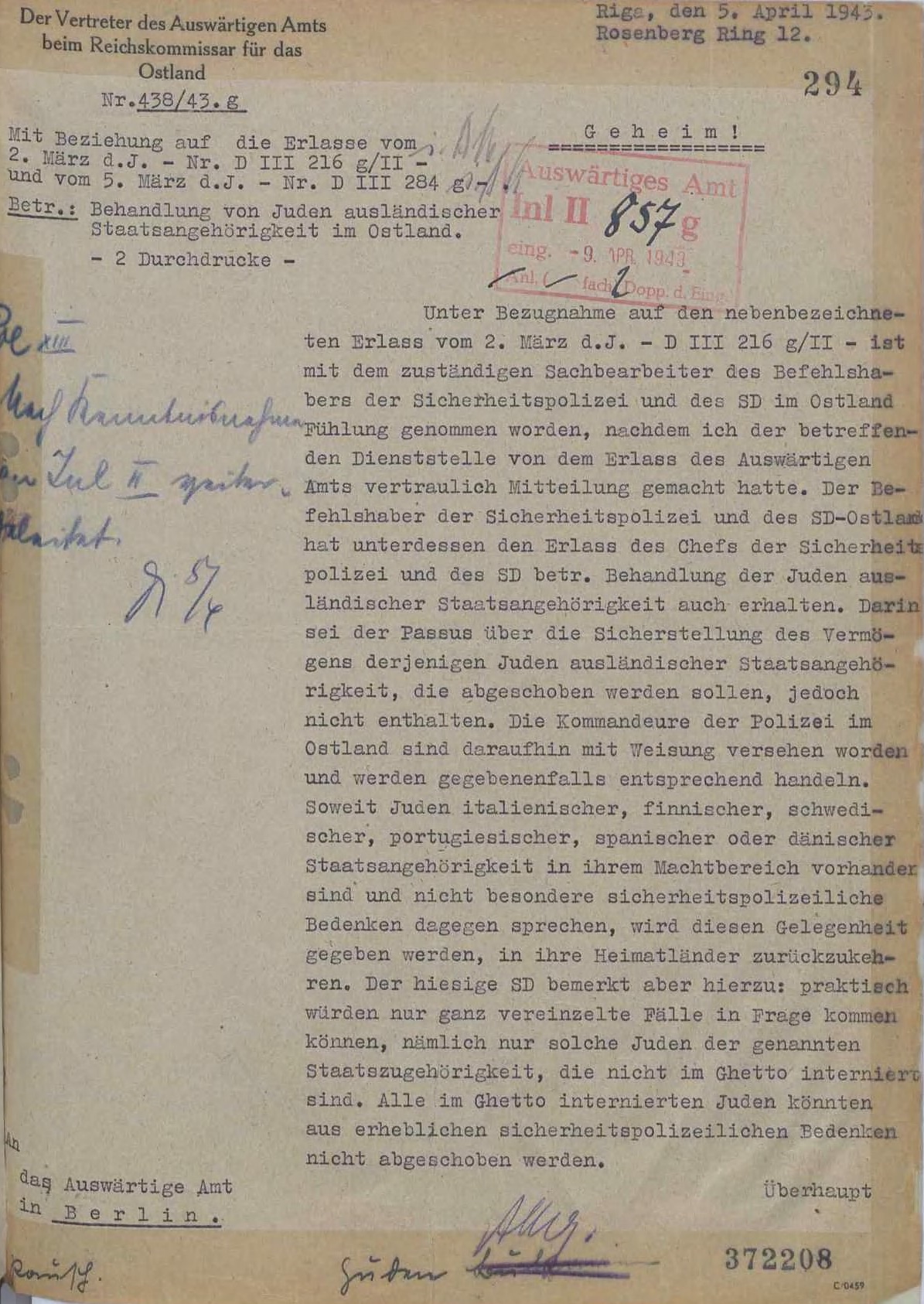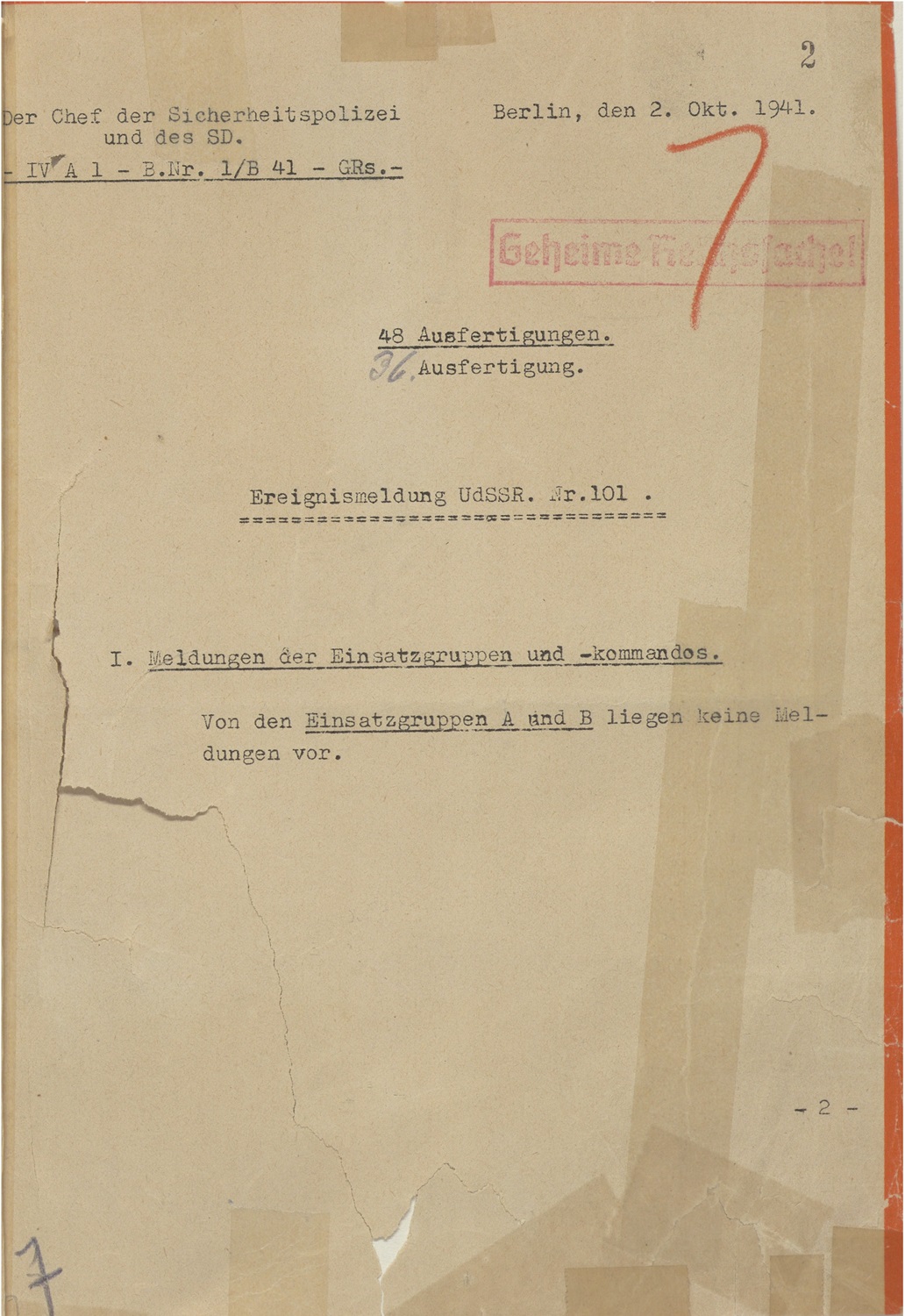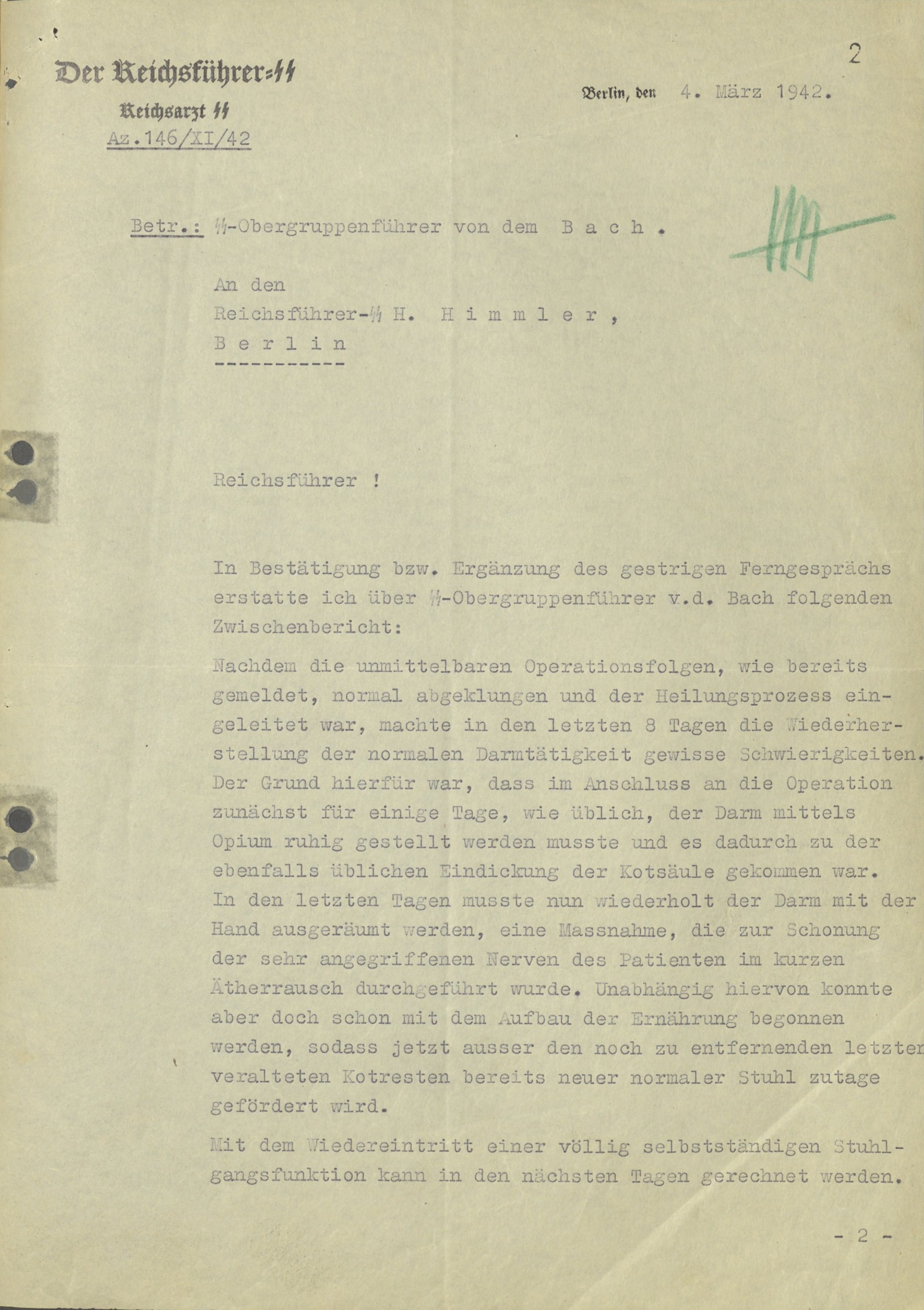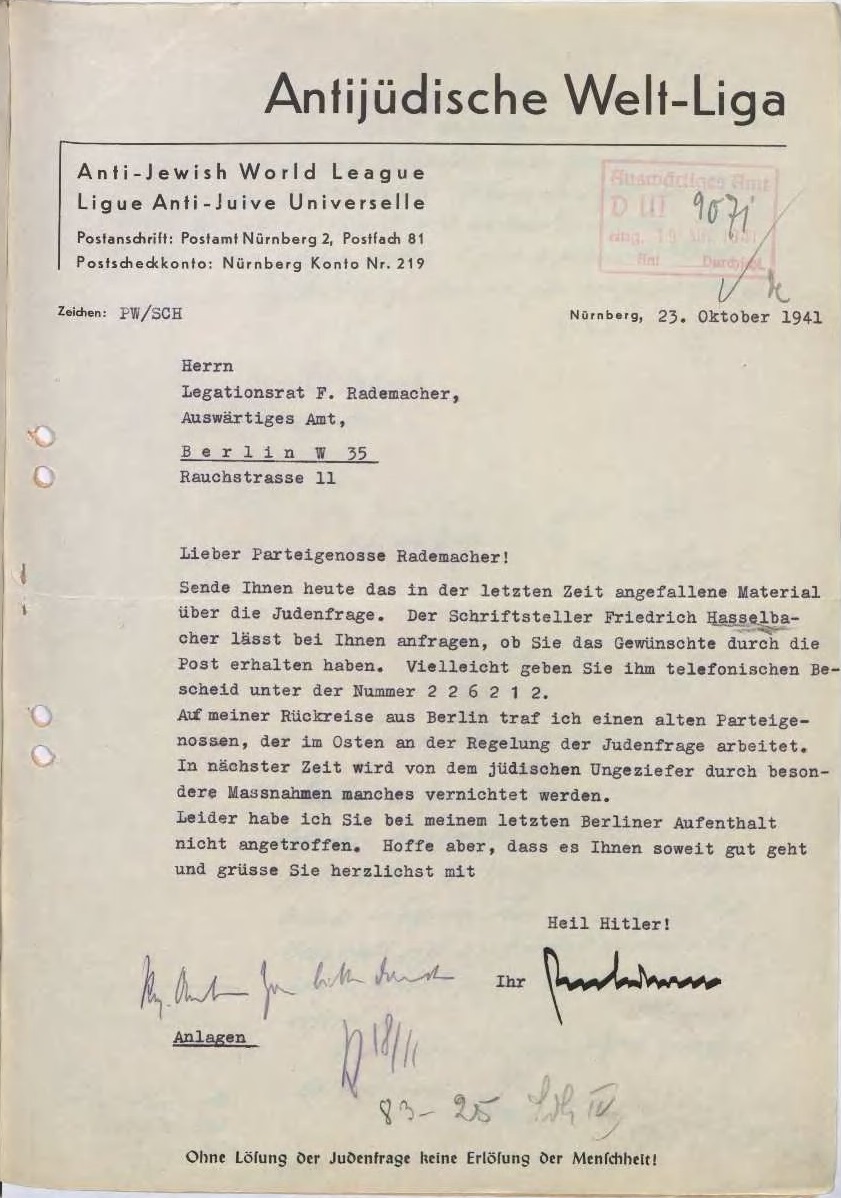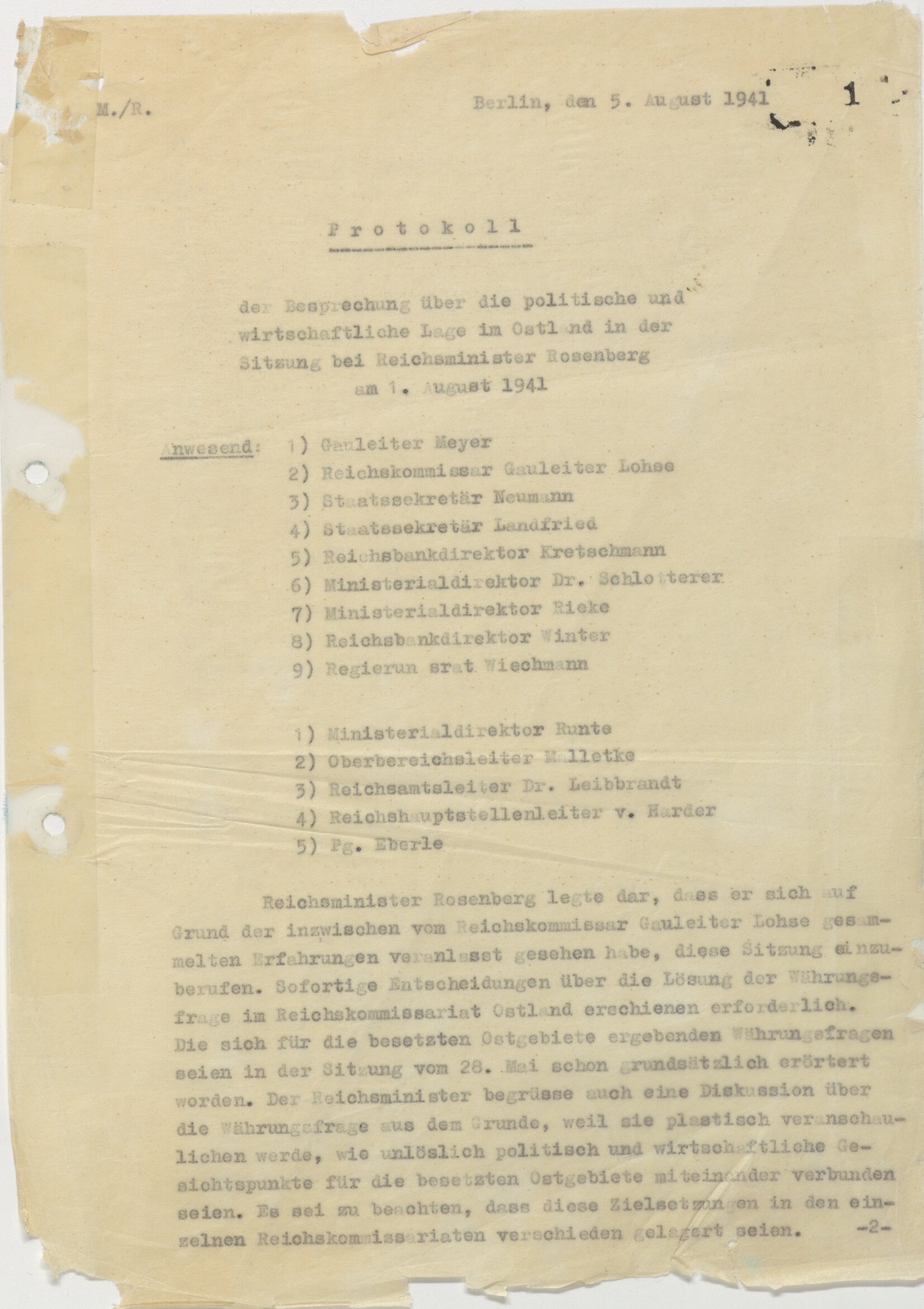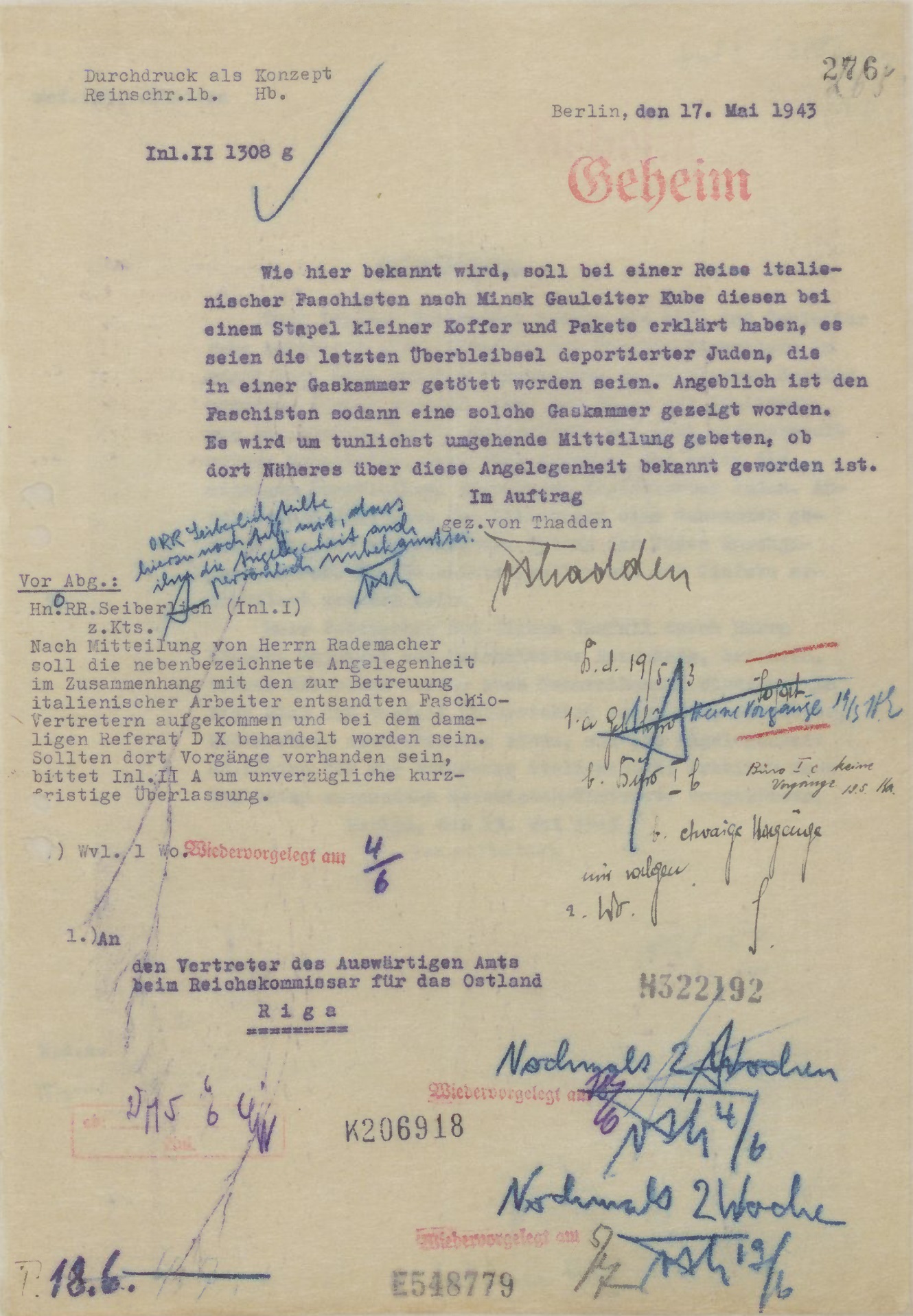Latest Posts
Memo dated June 5, 1942, authored by SS-Hauptsturmführer Willy Just of RSHA office II D 3 a (Motor Vehicle Department of the Security Police) on technical modifications to the gas vans used in mass killing operations. Just reports that "since December 1941 97,000 have been processed using 3 deployed vehicles, without any defects occurring in the vehicles" and "the known explosion in Kulmhof (Chełmno) is to be considered an isolated case due to an operating error". He proposes the following "technical modifications to the special vehicles currently in operation and those under production", among other things ventilation slots on the upper rear wall to allow "a rapid inflow of CO without causing overpressure". The proposal was reviewed by Walther Rauff, head of the Motor Vehicle Department, on June 10, 1942. He approved the implementation of the modifications on a prototype vehicle.Memo dated June 5, 1942, authored by SS-Hauptsturmführer Willy Just of RSHA office II D 3 a (Motor Vehicle Department of the Security Police) on technical modifications to the gas vans used in mass killing operations. Just reports that "since December 1941 97,000 have been processed using 3 deployed vehicles, without any defects occurring in the vehicles" and "the known explosion in Kulmhof (Chełmno) is to be considered an isolated case due to an operating error". He proposes the following "technical modifications to the special vehicles currently in operation and those under production", among other things ventilation slots on the upper rear wall to allow "a rapid inflow of CO without causing overpressure". The proposal was reviewed by Walther Rauff, head of the Motor Vehicle Department, on June 10, 1942. He approved the implementation of the modifications on a prototype vehicle.
The Swiss cardiologist and medical captain Robert Hegglin participated in the so-called third medical mission of the Swiss Red Cross, which took place in Riga, Daugavpils, and Pskov between 18 June and 26 September 1942. Over the course of several months, he documented his experiences in detail in his diary—from train journeys through ravaged Latvia and Russia to clinical cases in overstretched hospitals. Among his most entries is a report on the mass shootings of Jews in Nazi-occupied Latvia: "…based on the reports available to me from German soldiers, officers, and Latvians, that nearly 100,000 Jews have been shot in the Riga area alone since the German occupation. […] If the Germans truly require such bloody atrocities, then they are unfit to become the masters of Europe.”The Swiss cardiologist and medical captain Robert Hegglin participated in the so-called third medical mission of the Swiss Red Cross, which took place in Riga, Daugavpils, and Pskov between 18 June and 26 September 1942. Over the course of several months, he documented his experiences in detail in his diary—from train journeys through ravaged Latvia and Russia to clinical cases in overstretched hospitals. Among his most entries is a report on the mass shootings of Jews in Nazi-occupied Latvia: "…based on the reports available to me from German soldiers, officers, and Latvians, that nearly 100,000 Jews have been shot in the Riga area alone since the German occupation. […] If the Germans truly require such bloody atrocities, then they are unfit to become the masters of Europe.”
On September 1, 1944, Swiss envoy Hans Frölicher sent a letter to Swiss Foreign Minister Marcel Pilet-Golaz reporting on news he had picked up in Berlin. According to information from the SD (Security Service), the fugitive head of the Reich Criminal Police Office and former chief of Einsatzgruppe B, Arthur Nebe, was "carrying a large amount of material with him – notably orders concerning the extermination of Jews, the shooting of hostages, and other punitive actions". At the time, the SD feared he might hand this evidence over to the Allies. In reality, however, Nebe had not fled abroad – he was hiding near Berlin and was eventually captured by the Gestapo in January 1945. Footage of a mass gassing carried out by Einsatzkommando 8 of Einsatzgruppe B was discovered in his Berlin apartment after the war.On September 1, 1944, Swiss envoy Hans Frölicher sent a letter to Swiss Foreign Minister Marcel Pilet-Golaz reporting on news he had picked up in Berlin. According to information from the SD (Security Service), the fugitive head of the Reich Criminal Police Office and former chief of Einsatzgruppe B, Arthur Nebe, was "carrying a large amount of material with him – notably orders concerning the extermination of Jews, the shooting of hostages, and other punitive actions". At the time, the SD feared he might hand this evidence over to the Allies. In reality, however, Nebe had not fled abroad – he was hiding near Berlin and was eventually captured by the Gestapo in January 1945. Footage of a mass gassing carried out by Einsatzkommando 8 of Einsatzgruppe B was discovered in his Berlin apartment after the war.
The Event Report USSR No. 101 was issued by the Secret State Police on December 19, 1941. According to the report, over 17,000 Jews were killed in a series of so-called "special actions" by Einsatzgruppe B in November – December 1941. For example, it reported that in Bobruisk "a total of 5,281 Jews of both sexes were shot."The Event Report USSR No. 101 was issued by the Secret State Police on December 19, 1941. According to the report, over 17,000 Jews were killed in a series of so-called "special actions" by Einsatzgruppe B in November – December 1941. For example, it reported that in Bobruisk "a total of 5,281 Jews of both sexes were shot."
On February 3, 1944, Eichmann's office dispatched a letter, signed by the head of the RSHA, Ernst Kaltenbrunner, to Reichsführer-SS Heinrich Himmler. The letter sought a decision regarding the handling of SS and police personnel implicated in the escape of Jewish prisoners from Sonderkommando 1005 at Fort Kauen (Kaunas in Lithuanian). Kaltenbrunner asked that "the matter be concluded within our jurisdiction", keeping the the SS and police judiciary out of it to prevent "another group of persons gaining insight into the operation of the Sonderkommando". Led by Paul Blobel, Sonderkommando 1005, was tasked with the responsibility of erasing evidence of Nazi atrocities in the East by exhuming and incinerating bodies from mass graves.On February 3, 1944, Eichmann's office dispatched a letter, signed by the head of the RSHA, Ernst Kaltenbrunner, to Reichsführer-SS Heinrich Himmler. The letter sought a decision regarding the handling of SS and police personnel implicated in the escape of Jewish prisoners from Sonderkommando 1005 at Fort Kauen (Kaunas in Lithuanian). Kaltenbrunner asked that "the matter be concluded within our jurisdiction", keeping the the SS and police judiciary out of it to prevent "another group of persons gaining insight into the operation of the Sonderkommando". Led by Paul Blobel, Sonderkommando 1005, was tasked with the responsibility of erasing evidence of Nazi atrocities in the East by exhuming and incinerating bodies from mass graves.
The memo dated April 5, 1943, from Adolf Windecker (Representative of the Foreign Office to the Reich Commissioner for the Eastern Territories) discusses the "treatment of Jews of foreign nationality in the Eastern Territories." It specifies that all Jews confined to ghettos cannot be deported to other countries due to "significant security police concerns." Windecker acknowledges the large-scale killings in Riga noting that "many thousands of the local and Reich German Jews in the Riga area have been shot over time." As a result, he questions the feasibility of using any Jews for exchange purposes, as he fears that doing so would "be exploited abroad as evidence of the executions carried out here."The memo dated April 5, 1943, from Adolf Windecker (Representative of the Foreign Office to the Reich Commissioner for the Eastern Territories) discusses the "treatment of Jews of foreign nationality in the Eastern Territories." It specifies that all Jews confined to ghettos cannot be deported to other countries due to "significant security police concerns." Windecker acknowledges the large-scale killings in Riga noting that "many thousands of the local and Reich German Jews in the Riga area have been shot over time." As a result, he questions the feasibility of using any Jews for exchange purposes, as he fears that doing so would "be exploited abroad as evidence of the executions carried out here."
On October 2, 1941, Office IV of the Reich Security Main Office (RSHA) issued Event Report USSR No. 101 (Ereignismeldung UdSSR Nr. 101). Einsatzgruppe C reported on the massacre at the Babyn Yar (Babi Yar) near Kiev that Paul Blobel's Sonderkommando 4a "executed 33,771 Jews in Kiev on September 29 and 30, 1941". Meanwhile, Einsatzgruppe D stated that "between September 16 and 30, 22,467 Jews and Communists were executed, bringing the total to 35,782".On October 2, 1941, Office IV of the Reich Security Main Office (RSHA) issued Event Report USSR No. 101 (Ereignismeldung UdSSR Nr. 101). Einsatzgruppe C reported on the massacre at the Babyn Yar (Babi Yar) near Kiev that Paul Blobel's Sonderkommando 4a "executed 33,771 Jews in Kiev on September 29 and 30, 1941". Meanwhile, Einsatzgruppe D stated that "between September 16 and 30, 22,467 Jews and Communists were executed, bringing the total to 35,782".
In this letter dated March 4, 1942, the Reichsarzt SS Ernst-Robert Grawitz describes the medical condition and recovery process of the Higher SS and Police Leader for the central zone in Russia Erich von dem Bach-Zelewski, whose role in leading executions in the East left mental scars. Grawitz notes that von dem Bach suffered from "severe nervous exhaustion…from thoughts related to the executions of Jews that he himself oversaw".In this letter dated March 4, 1942, the Reichsarzt SS Ernst-Robert Grawitz describes the medical condition and recovery process of the Higher SS and Police Leader for the central zone in Russia Erich von dem Bach-Zelewski, whose role in leading executions in the East left mental scars. Grawitz notes that von dem Bach suffered from "severe nervous exhaustion…from thoughts related to the executions of Jews that he himself oversaw".
On February 13, 1942, Reinhard Heydrich's adjutant, SS-Hauptsturmführer Hans-Achim Ploetz, forwarded a report from Einsatzgruppe A to the staff of Reichsführer-SS Heinrich Himmler on the "defeatist" remarks made by SS-Sturmbannführer and Oberstleutnant Arno von Kriegsheim. Among other statements, Kriegsheim expressed that "executing Jews is unworthy of a German." The report also noted that "similar statements, albeit in less severe forms, were made by almost all the officers of the Commander of the Rear Army Area North during the first months of the Eastern campaign."On February 13, 1942, Reinhard Heydrich's adjutant, SS-Hauptsturmführer Hans-Achim Ploetz, forwarded a report from Einsatzgruppe A to the staff of Reichsführer-SS Heinrich Himmler on the "defeatist" remarks made by SS-Sturmbannführer and Oberstleutnant Arno von Kriegsheim. Among other statements, Kriegsheim expressed that "executing Jews is unworthy of a German." The report also noted that "similar statements, albeit in less severe forms, were made by almost all the officers of the Commander of the Rear Army Area North during the first months of the Eastern campaign."
Paul Wurm, the Foreign Editor of the Nazi propaganda newspaper Der Stürmer and head of the so-called "Anti-Jewish World League," wrote a letter on October 23, 1941, to Franz Rademacher, the Foreign Office's expert on Jewish affairs. In this letter, Wurm mentioned a recent encounter with "an old party comrade" who was actively involved in implementing the "resolution of the Jewish Question" in the East. According to Wurm, this old party comrade disclosed that "much will be destroyed of the Jewish vermin through special measures".Paul Wurm, the Foreign Editor of the Nazi propaganda newspaper Der Stürmer and head of the so-called "Anti-Jewish World League," wrote a letter on October 23, 1941, to Franz Rademacher, the Foreign Office's expert on Jewish affairs. In this letter, Wurm mentioned a recent encounter with "an old party comrade" who was actively involved in implementing the "resolution of the Jewish Question" in the East. According to Wurm, this old party comrade disclosed that "much will be destroyed of the Jewish vermin through special measures".
On August 1, 1941, Reich Minister Alfred Rosenberg led a high-level meeting to discuss the governance of Nazi-occupied territories in Eastern Europe. Hinrich Lohse, the Reichskommissar for Ostland and Gauleiter of Schleswig-Holstein, reported that "approximately 10,000 Jews had been liquidated by the Lithuanian population". Lohse emphasized that, following Hitler’s directive, "the Jews should be completely removed from this area".On August 1, 1941, Reich Minister Alfred Rosenberg led a high-level meeting to discuss the governance of Nazi-occupied territories in Eastern Europe. Hinrich Lohse, the Reichskommissar for Ostland and Gauleiter of Schleswig-Holstein, reported that "approximately 10,000 Jews had been liquidated by the Lithuanian population". Lohse emphasized that, following Hitler’s directive, "the Jews should be completely removed from this area".
Between 20 and 29 September 1942, an Italian delegation led by Fascist Party secretary Aldo Vidussoni traveled from Milan through Litzmannstadt, Brest-Litowsk, Minsk, and Kharkov, reaching Millerovo near Rostov. Vidussoni's account, recorded in Mussolini's Secretariat documents, notes that "in Minsk, at the Opera Theater, we saw the belongings of thousands and thousands of murdered Jews piled up" and that "what struck the Italians the most was the method of killing". In mid-May 1943, the German Foreign Office learnt about the incident from a report that Wilhelm Kube, the Generalkommissar for Belarus, had shown the Italian fascist delegation in Minsk "a gas chamber where the killing of Jews was supposedly carried out." At the time, in September 1942, homicidal gas vans were actively operating near Minsk.Between 20 and 29 September 1942, an Italian delegation led by Fascist Party secretary Aldo Vidussoni traveled from Milan through Litzmannstadt, Brest-Litowsk, Minsk, and Kharkov, reaching Millerovo near Rostov. Vidussoni's account, recorded in Mussolini's Secretariat documents, notes that "in Minsk, at the Opera Theater, we saw the belongings of thousands and thousands of murdered Jews piled up" and that "what struck the Italians the most was the method of killing". In mid-May 1943, the German Foreign Office learnt about the incident from a report that Wilhelm Kube, the Generalkommissar for Belarus, had shown the Italian fascist delegation in Minsk "a gas chamber where the killing of Jews was supposedly carried out." At the time, in September 1942, homicidal gas vans were actively operating near Minsk.
On December 29, 1942, SS-Reichsführer Heinrich Himmler delivered a report to Adolf Hitler, mentioning the execution of 363,211 Jews within only four months, between August and November of that year. Himmler’s report, known as report no. 51 to the Führer on Bandit Fighting, provides one of the clearest examples of high-level documentation of the Holocaust.On December 29, 1942, SS-Reichsführer Heinrich Himmler delivered a report to Adolf Hitler, mentioning the execution of 363,211 Jews within only four months, between August and November of that year. Himmler’s report, known as report no. 51 to the Führer on Bandit Fighting, provides one of the clearest examples of high-level documentation of the Holocaust.

